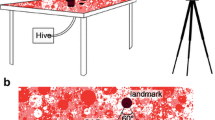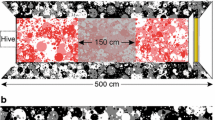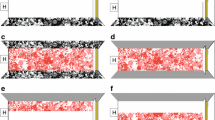Abstract
The flight control systems of flying insects enable many kinds of sophisticated maneuvers, including avoidance of midair collisions. Visuomotor response to an approaching object, received as image expansion on insects’ retina, is a complex event in a dynamic environment where both animals and objects are moving. There are intensive free flight studies on the landing response in which insects receive image expansion by their own movement. However, few studies have been conducted regarding how freely flying insects respond to approaching objects. Here, using common laboratory insects for behavioral research, the bumblebee Bombus ignitus, we examined their visual response to an approaching object in the free-flying condition. While the insect was slowly flying in a free-flight arena, an expanding stripe was projected laterally from one side of the arena with a high-speed digital mirror device projector. Rather than turning away reported before, the bumble bees performed complex flight maneuvers. We synchronized flight trajectories, orientations and wing stroke frequencies with projection parameters of temporal resolution in 0.5 ms, and analyzed the instantaneous relationship between visual input and behavioral output. In their complex behavioral responses, we identified the following two visuomotor behaviors: increasing stroke frequency when the bumble bees confront the stripe expansion, and turning towards (not away) the stripe expansion when it is located laterally to the bee. Our results suggested that the response to object expansion is not a simple and reflexive escape but includes object fixation, presumably for subsequent behavioral choice.






Similar content being viewed by others
Abbreviations
- α :
-
Angular deference between body orientation and flight direction
- β:
-
Body axis angle
- θ :
-
Αngular width
- AW:
-
Angular width
- FV:
-
Forward velocity
- GLMs:
-
General linear models
- IR:
-
Infrared
- L :
-
Half-width of the simulated stripe
- PS:
-
Projection speed
- T:
-
Stroke period
- t :
-
Time
- V :
-
Simulated approaching speed
- YTA:
-
Yaw turn angular velocity
- Zone:
-
Visual zone
References
Bahl A, Ammer G, Schilling T, Borst A (2013) Object tracking in motion-blind flies. Nat Neurosci 16(6):730–738. https://doi.org/10.1038/nn.3386
Baird E, Boeddeker N, Ibbotson MR, Srinivasan MV (2013) A universal strategy for visually guided landing. Proc Natl Acad Sci U S A 110:18686–18691. https://doi.org/10.1073/pnas.1314311110
Baker PS (1979) Flying locust visual responses in a radial wind-tunnel. J Comp Physiol 131:39–47
Bender JA, Dickinson MH (2006) Visual stimulation of saccades in magnetically tethered Drosophila. J Exp Biol 209:3170–3182. https://doi.org/10.1242/Jeb.02369
Borst A (1990) How do flies land? Bioscience 40:292–299. https://doi.org/10.2307/1311266
Borst A (2014) Fly visual course control: behaviour, algorithms and circuits. Nat Rev Neurosci 15(9):590–599. https://doi.org/10.1038/nrn3799
Borst A, Bahde S (1988) Visual information processing in the fly’s landing system. J Comp Physiol A 163:167–173. https://doi.org/10.1007/Bf00612426
Borst A, Egelhaaf M (1989) Principles of visual-motion detection. Trends Neurosci 12:297–306. https://doi.org/10.1016/0166-2236(89)90010-6
van Breugel F, Dickinson MH (2012) The visual control of landing and obstacle avoidance in the fruit fly Drosophila melanogaster. J Exp Biol 215:1783–1798. https://doi.org/10.1242/Jeb.066498
Burkhardt D (1977) On the vision of insects. J Comp Physiol A 120:33–50. https://doi.org/10.1007/BF00617536
Card G, Dickinson MH (2008) Visually mediated motor planning in the escape response of Drosophila. Curr Biol 18:1300–1307. https://doi.org/10.1016/j.cub.2008.07.094
Chan RWM, Gabbiani F (2013) Collision-avoidance behaviors of minimally restrained flying locusts to looming stimuli. J Exp Biol 216:641–655. https://doi.org/10.1242/jeb.077453
Combes SA, Rundle DE, Iwasaki JM, Crall JD (2012) Linking biomechanics and ecology through predator-prey interactions: flight performance of dragonflies and their prey. J Exp Biol 215:903–913. https://doi.org/10.1242/jeb.059394
Douskos V, Kalisperakis I, Karras G (2007) Automatic calibration of digital cameras using planar chess-board patterns. Int Arch Photogramm Remote Sens Spat Inf Sci XXXIX(B5):45–49
Duistermars BJ, Chow DM, Condro M, Frye MA (2007a) The spatial, temporal and contrast properties of expansion and rotation flight optomotor responses in Drosophila. J Exp Biol 210:3218–3227. https://doi.org/10.1242/jeb.007807
Duistermars BJ, Reiser MB, Zhu Y, Frye MA (2007b) Dynamic properties of large-field and small-field optomotor flight responses in Drosophila. J Comp Physiol A 193:787–799. https://doi.org/10.1007/s00359-007-0233-y
Egelhaaf M, Hausen K, Reichardt W, Wehrhahn C (1988) Visual course control in flies relies on neuronal computation of object and background motion. Trends Neurosci 11:351–358
Egelhaaf M, Boeddeker N, Kern R, Kurtz R, Lindemann JP (2012) Spatial vision in insects is facilitated by shaping the dynamics of visual input through behavioral action. Front Neural Circuit 6:108. https://doi.org/10.3389/Fncir.2012.00108
Evangelista C, Kraft P, Dacke M, Reinhard J, Srinivasan MV (2010) The moment before touchdown: landing manoeuvres of the honeybee Apis mellifera. J Exp Biol 213:262–270. https://doi.org/10.1242/jeb.037465
Fotowat H, Gabbiani F (2007) Relationship between the phases of sensory and motor activity during a looming-evoked multistage escape behavior. J Neurosci 27:10047–10059. https://doi.org/10.1523/Jneurosci.1515-07.2007
Fotowat H, Fayyazuddin A, Bellen HJ, Gabbiani F (2009) A novel neuronal pathway for visually guided escape in Drosophila melanogaster. J Neurophysiol 102:875–885. https://doi.org/10.1152/jn.00073.2009
Gabbiani F, Krapp HG, Laurent G (1999) Computation of object approach by a wide-field, motion-sensitive neuron. J Neurosci 19:1122–1141
Gray JR, Lee JK, Robertson RM (2001) Activity of descending contralateral movement detector neurons and collision avoidance behaviour in response to head-on visual stimuli in locusts. J Comp Physiol A 187(2):115–129. https://doi.org/10.1007/s003590100182
Hassenstein B, Reichardt W (1956) Systemtheoretische Analyse Der Zeit, Reihenfolgen Und Vorzeichenauswertung Bei Der Bewegungsperzeption Des Russelkafers Chlorophanus. Z Naturforsch Pt B 11(9–10):513–524
Hedrick T, Cheng B, Deng X (2009) Wingbeat time and the scaling of passive rotational damping in flapping flight. Science 324:252–255. https://doi.org/10.1126/science.1168431
Heisenberg M, Wolf R (1979) On the fine-structure of yaw torque in visual flight orientation of Drosophila melanogaster. J Comp Physiol 130:113–130
Heisenberg M, Wolf R (1984) Vision in Drosophila: genetics of microbehavior. Springer-Verlag, Berlin
Ishii HS, Masuda H (2014) Effect of flower visual angle on flower constancy: a test of the search image hypothesis. Behav Ecol 25:933–944. https://doi.org/10.1093/beheco/aru071
Kramer DL, Bonenfant M (1997) Direction of predator approach and the decision to flee to a refuge. Anim Behav 54:289–295. https://doi.org/10.1006/anbe.1996.0360
Lehmann FO, Dickinson MH (1997) The changes in power requirements and muscle efficiency during elevated force production in the fruit fly Drosophila melanogaster. J Exp Biol 200:1133–1143
Lehrer M (1998) Looking all around: honeybees use different cues in different eye regions. J Exp Biol 201(24):3275–3292
Maimon G, Straw AD, Dickinson MH (2008) A simple vision-based algorithm for decision making in flying Drosophila. Curr Biol 18:464–470. https://doi.org/10.1016/j.cub.2008.02.054
Muijres FT, Elzinga MJ, Melis JM, Dickinson MH (2014) Flies Evade Looming Targets by Executing Rapid Visually Directed Banked Turns. Science 344(6180):172–177
Reber T, Vahakainu A, Baird E, Weckstrom M, Warrant E, Dacke M (2015) Effect of light intensity on flight control and temporal properties of photoreceptors in bumblebees. J Exp Biol 218:1339–1346. https://doi.org/10.1242/jeb.113886
Reber T, Dacke M, Warrant E, Baird E (2016) Bumblebees perform well-controlled landings in dim light. Front Behav Neurosci 10:174. https://doi.org/10.3389/fnbeh.2016.00174
Reichardt W, Wenking H (1969) Optical detection and fixation of objects by fixed flying flies. Naturwissenschaften 56(8):424–424. https://doi.org/10.1007/BF00593644
Reiser MB, Dickinson MH (2010) Drosophila fly straight by fixating objects in the face of expanding optic flow. J Exp Biol 213:1771–1781. https://doi.org/10.1242/jeb.035147
Ribak G, Rand D, Weihs D, Ayali A (2012) Role of wing pronation in evasive steering of locusts. J Comp Physiol A 198:541–555. https://doi.org/10.1007/s00359-012-0728-z
Robertson RM, Johnson AG (1993a) Collision avoidance of flying locusts: steering torques and behaviour. J Exp Biol 183:35–60
Robertson RM, Johnson AG (1993b) Retinal image size triggers obstacle avoidance in flying locusts. Naturwissenschaften 80:176–178. https://doi.org/10.1007/BF01226378
Rodríguez-Prieto I, Fernández-Juricic E, Martín J (2006) Anti-predator behavioral responses of mosquito pupae to aerial predation risk. J Insect Behav 19:373–381. https://doi.org/10.1007/s10905-006-9033-4
Santer RD, Simmons PJ, Rind FC (2004) Gliding behaviour elicited by lateral looming stimuli in flying locusts. J Comp Physiol A 191:61–73. https://doi.org/10.1152/jn.00024.2006
Schilling T, Borst A (2015) Local motion detectors are required for the computation of expansion flow-fields. Biology open 4(9):1105–1108. https://doi.org/10.1242/bio.012690
Spaethe J, Chittka L (2003) Interindividual variation of eye optics and single object resolution in bumblebees. J Exp Biol 206:3447–3453. https://doi.org/10.1242/jeb.00570
Srinivasan MV (2011) Honeybees as a model for the study of visually guided flight, navigation, and biologically inspired robotics. Physiol Rev 91:413–460. https://doi.org/10.1016/j.conb.2011.05.020
Srinivasan MV, Zhang SW, Chahl JS, Barth E, Venkatesh S (2000) How honeybees make grazing landings on flat surfaces. Biol Cybern 83:171–183. https://doi.org/10.1007/s004220000162
Stavenga D G (1979) Pseudopupils of compound eyes. In “Handbook of sensory physiology VII/6A”, Ed by H Autrum, Springer-Verlag, Berlin, pp 357–439. doi: https://doi.org/10.1007/978-3-642-66999-6_7
Tammero LF, Dickinson MH (2002a) Collision-avoidance and landing responses are mediated by separate pathways in the fruit fly, Drosophila melanogaster. J Exp Biol 205:2785–2798
Tammero LF, Dickinson MH (2002b) The influence of visual landscape on the free flight behavior of the fruit fly Drosophila melanogaster. J Exp Biol 205:327–343
Tammero LF, Frye MA, Dickinson MH (2004) Spatial organization of visuomotor reflexes in Drosophila. J Exp Biol 207:113–122. https://doi.org/10.1242/jeb.00724
Tanaka K, Kawachi K (2006) Response characteristics of visual altitude control system in Bumbus terrestris. J Exp Biol 209:4533–4545. https://doi.org/10.1242/jeb.02552
Verspui R, Gray JR (2009) Visual stimuli induced by self-motion and object-motion modify odour-guided flight of male moths (Manduca sexta L.). J Exp Biol 212 (20):3272–3282
Wolf R, Heisenberg M (1980) On the fine-structure of yaw torque in visual flight orientation of Drosophila melanogaster. 2. A temporally and spatially variable weighting function for the visual-field (visual-attention). J Comp Physiol 140:69–80
Ydenberg RC, Dill LM (1986) The economics of fleeing from predators. Adv Study Behav 16:229–249. https://doi.org/10.1016/S0065-3454(08)60192-8
Acknowledgements
We gratefully acknowledge Masahiro Mitsuhata for providing valuable suggestions about bumble bees’ behavior. We thank Arysta LifeScience Corporation for supplying bumble bees. This research was conducted in collaboration with Nissan Motor, Co., Ltd., and partially supported by JSPS KAKENHI (24120007) and NSFC (61375096).
Author information
Authors and Affiliations
Corresponding authors
Ethics declarations
Conflict of Interest
The authors declare no conflicts of interest.
Electronic supplementary material
ESM 1
(DOCX 225 kb)
Rights and permissions
About this article
Cite this article
Wang, H., Ando, N., Takahashi, H. et al. Visuomotor Response to Object Expansion in Free-Flying Bumble Bees. J Insect Behav 30, 612–631 (2017). https://doi.org/10.1007/s10905-017-9645-x
Revised:
Accepted:
Published:
Issue Date:
DOI: https://doi.org/10.1007/s10905-017-9645-x




